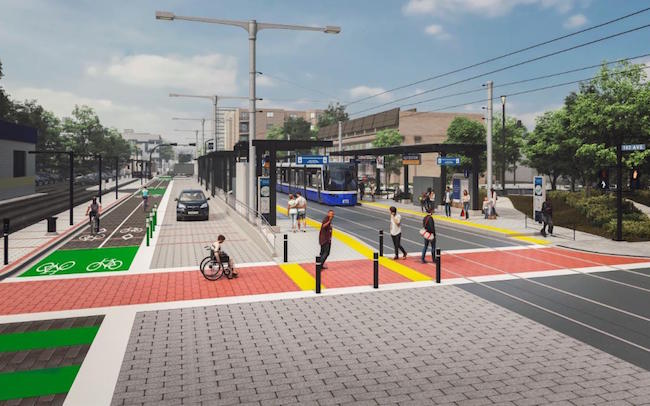
Crunching the numbers: New AI tool brings construction scheduling into modern era
By David Kennedy
Infrastructure Risk Management Software
An AI-powered tool, ALICE relies on human input for the initial parameters, while turning to computing power for crunching the numbers. PHOTO: Adobe Stock/knssr
An experienced project scheduler can spend months mapping out one, or perhaps two, iterations for a complex construction job. “ALICE” can simulate and assess millions in the course of an afternoon.
It takes planning teams from a reality where they often have just a single option, to a simulation where the number of sequences are practically limitless, says René Morkos, the CEO and co-founder of ALICE Technologies Inc. “You add a crane, add a delay, change the design, try overtime, try fast-drying concrete [or] change the amount of formwork. Whatever it is that you want to do, you change it, and the change ripples through your system.”
A generative construction simulator powered by artificial intelligence, ALICE, an acronym drawn from ArtificiaL Intelligence Construction Engineering, gives construction firms plotting out projects the ability to optimize resources, fine-tune their timing and overcome constraints in ways that human planners couldn’t work through alone.
“Let the humans do what they’re good at, which is the gut sense, the understanding of reality, the risk analysis, those kinds of things,” Morkos says. “Let the machines do what they’re good at, which is crunching.”
It’s one tool in a growing arsenal of software solutions to which contractors are turning to tackle increasingly complicated projects in an industry that’s always had to juggle a huge number of moving parts.
In five or six years, when light rail vehicles begin running along the 14-kilometre second phase of Edmonton’s Valley Line, it’s ALICE — guided by the scheduling team at Parsons Corp. — riders will have to thank for the construction sequencing that laid the roadmap for the project.
“With ALICE, you still need that experienced scheduler to do the planning, but once you do the iterations, you can run a million iterations and then you take those iterations and you analyze them,” says Elie Homsi, senior vice-president of Parsons. “It is that limitation on the number of iterations that you can be running to optimize resources, optimize time, cost schedule, or whatever constraint the project has, that you are benefitting from.”
Parsons, a technology firm that takes on both physical and digital infrastructure work, is one member of the Marigold Infrastructure Partners (MIP), the consortium responsible for the $2.6 billion Valley Line — West. It is working alongside Standard General and its parent firm Colas Group to build the new LRT system. Francl Architecture, Fast & Epp and Stantec Inc. are also involved on the design side.
“In Edmonton, we are working right now on finalizing our base schedule, and when we finish finalizing our base schedule, that team will start working on ALICE on that project to see also how we can improve the schedule and the delivery,” Homsi says.
Construction is expected to get underway in the Alberta capital this year. Crews will be on-site building the western portion of the Valley Line until at least 2026. Once complete, the overall transit system will stretch 27 kilometres.
While Parsons will be using ALICE during the construction phase, it also played a role for the MIP team in procurement as the consortium estimated costs and prepared its bid.
Homsi notes that a detailed construction schedule is a normal requirement when bidding on major infrastructure projects, but ALICE “takes what was available to a new height.”
“It’s unusual to see the level of details ALICE can put on the table pre-bid,” he says.

Human schedulers tell the AI tool the project “rules” and then allow it to create sequences based on a range of different parameters to find the optimal way forward. PHOTO: Alice Technologies
Likening ALICE to a laboratory, which lets schedulers experiment to find the optimal construction roadmap, Morkos says the simulator takes anywhere from a week to a month to set up, depending on the complexity of the project.
“Instead of figuring out how to build it, I just tell the software what are the rules that are involved,” he says. “What are the tasks? What are the resources? What are the calendars? Set it up and then I press the simulate button.”
Creating the rules and having ALICE generate myriad sequences are the first two parts of the process. The third lets schedulers analyze and change the planning parameters as they see fit. On average, Morkos notes, relying on the AI tool translates to a 17 per cent reduction in total construction duration and drives a 13 per cent decline in labour and equivalency.
At Parsons, Homsi says trimming costs is one component of using ALICE, but the company is still working on quantifying exactly how much it’s saving. For the moment, he’s watching the qualitative impacts closest, noting one clear benefit of the tool is its ability to make less experienced schedulers more accurate.
The Edmonton LRT project is also not the first job on which Parsons has used ALICE. It has been piloting the AI system on a handful of projects in North America and elsewhere for several years, including on an expansion project along Ontario’s Highway 401. Incrementally handing it more responsibility on each successive project, Homsi says if the software ultimately makes the cut, the company will roll it out for all of its work.
Meanwhile, the team at ALICE Technologies is not standing still. Having focussed on the bidding and pre-construction process first, the company launched what’s known as the Manage feature a few months back. As the name implies, it’s designed to keep projects on track as they’re built and can troubleshoot the best way forward when issues do arise.

A rendering of the Alex Decoteau on Edmonton’s new Valley Line — West LRT project. The team responsible for the new line is employing ALICE. PHOTO: City of Edmonton
“It becomes really easy to update progress and schedule, and re-sequence,” Morkos says.
The feature has also broadened the market for what was originally conceived as a solution to a problem Morkos encountered early in his construction career. Tasked with finding the optimal way to sequence construction on a series of landing strips for fighter jets, he searched for the proper tool to tackle the issue, but came up empty-handed. Running up against the same issue on project after project, he spent years looking for software capable of running the algorithms required.
“Long story short,” he says, skimming over both a masters degree and a PhD focused on artificial intelligence applications for construction, “I ended up building it.”
With its pre-construction tool, ALICE appealed mainly to schedulers. The Manage feature has prompted some of the Menlo Park, Calif.-based company’s first conversations with owners looking for added insight into their projects. It has made it more viable for use on smaller projects as well. While in the past, companies tended to turn to ALICE for projects worth at least $100 million, the Manage function and a plug-and-play template are pushing that threshold lower, Morkos says, pointing to new commercial jobs in the $20 million to $30 million range.
Homsi, meanwhile, says the decision to use ALICE should hinge more on the difficulty of the project rather than its price tag.
“If it’s a billion-dollar highway in the middle of the tundra, there might be some benefit, but even if it’s a smaller project with complex utility and phasing and all the stuff going on top of each other, that would be where we would be using it,” Homsi says. “It’s the complexity rather than the dollar value.”




